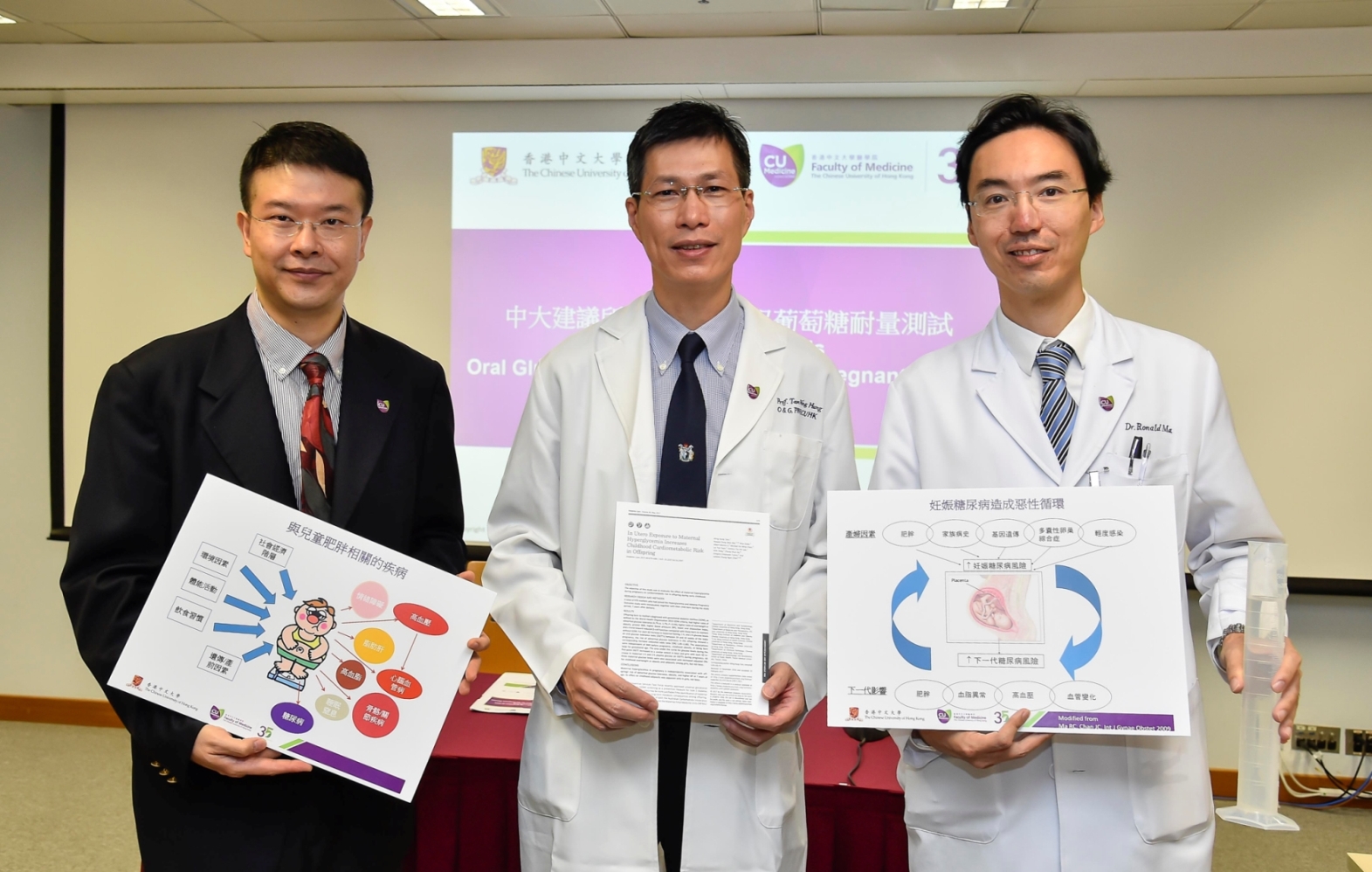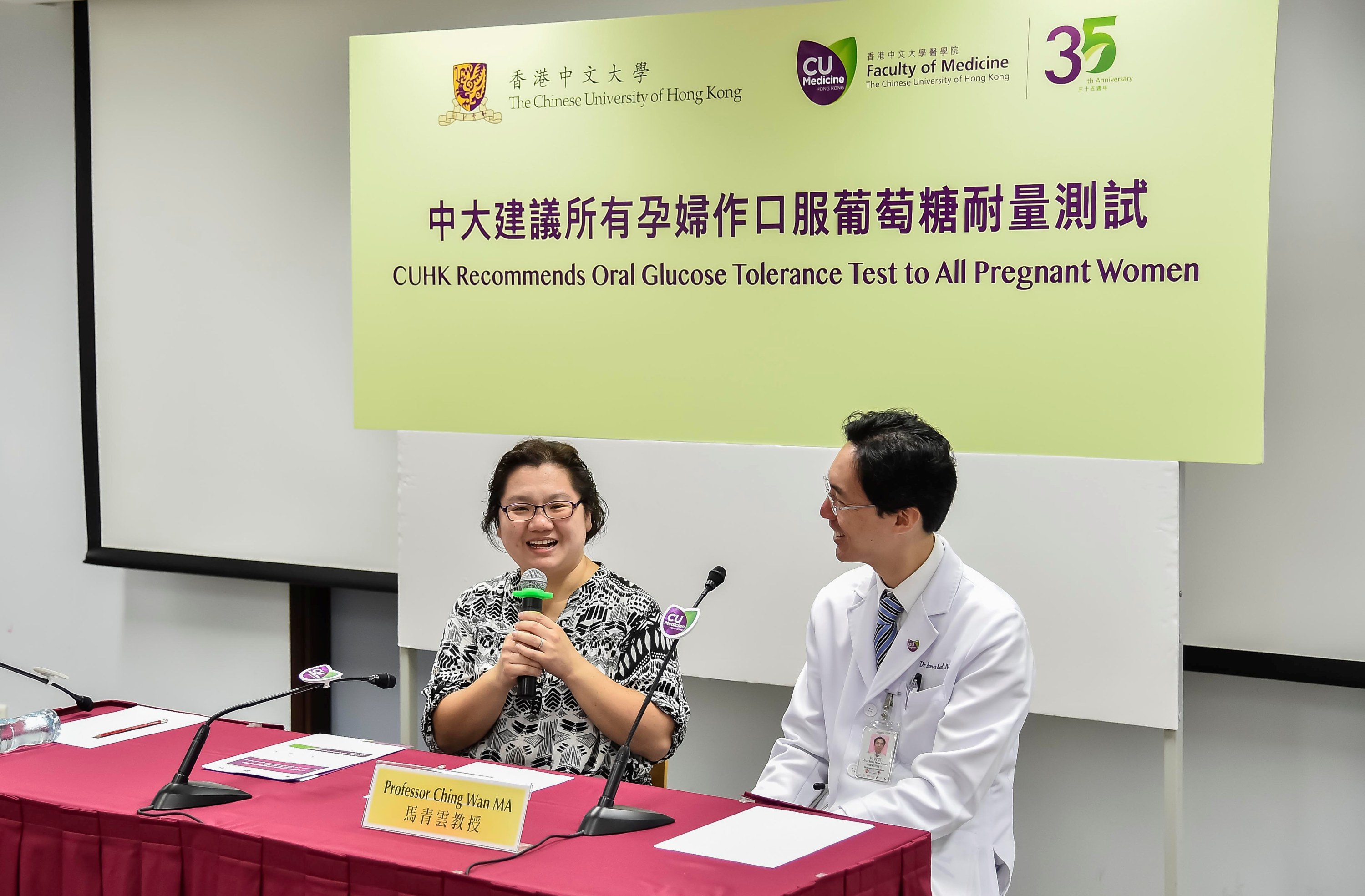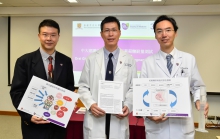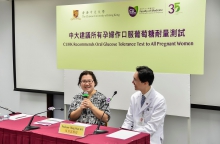CUHK
News Centre
CUHK Recommends Oral Glucose Tolerance Test for All Pregnant WomenStudy Reveals Children of Women with Gestational Diabetes Mellitus Have 3-Fold Diabetes Risk
A recent study conducted by the Faculty of Medicine at The Chinese University of Hong Kong (CUHK) found that the risk of developing prediabetes or diabetes for children born to mothers who suffered from gestational diabetes mellitus (GDM) is 3 times that of those who were born to mothers with normal blood glucose level. These children also have a 50% higher rate of overweight and obesity. Researchers recommend all pregnant women to take an oral glucose tolerance test (OGTT) for diagnosis of GDM, so that mothers can adjust their living habits or receive treatments to reduce the impact of GDM on both themselves and their offspring. The study results have been published in the leading international medical journal Diabetes Care in May 2017.
At least 20% of local pregnant women suffer from GDM
Pregnant women usually have a slightly higher blood glucose level for development of the fetus. However, hormonal changes in pregnant women may also lead to insulin resistance resulting in a higher glucose level, a condition known as GDM. Asians are a high-risk group for diabetes and GDM. Pregnant women with other risk factors like obesity (Body Mass Index, BMI, before pregnancy ≥ 25 kg/m2), advanced maternal age (35 years old or above), multiple pregnancy, having given birth to baby(ies) weighing over 4kg and having family history of diabetes, are more likely to suffer from GDM. Rapid weight gain due to excessive intake of nutrients during pregnancy can also lead to GDM. According to the figures in 2016, it is estimated that at least 20% of pregnant women in Hong Kong have GDM, significantly higher than the 12% recorded 25 years ago.
GDM could be diagnosed by OGTT. According to international definition, a pregnant woman is diagnosed with GDM if her fasting plasma glucose level ≥ 5.1 mmol/L, 1-hour plasma glucose level ≥ 10.0 mmol/L, or 2-hour plasma glucose level ≥ 8.5 mmol/L. GDM is associated with several adverse outcomes, e.g. pre-eclampsia, macrosomia, preterm delivery, polyhydramnios, and in some cases caesarean section is necessary. The recent research by CUHK reveals that GDM is also associated with cardiometabolic risk in the next generation.
Study proves GDM increases offspring’s risk of overweight and obesity by 50%
Between 2009 and 2013, the Department of Obstetrics and Gynaecology, Department of Medicine and Therapeutics, and Department of Paediatrics of the Faculty of Medicine at CUHK followed up on the cases of around 1,000 mothers who had joined the ‘Hyperglycemia and Adverse Pregnancy Outcome’ (HAPO) study together with their children of an average age of 7 years. Results are as follows:
|
|
Children born to mother with GDM (132 persons) |
Children born to mother with normal glucose tolerance (794 persons) |
|
Suffer from prediabetes or diabetes |
4.7% |
1.7% |
|
Overweight and obesity |
22.7% |
15.3% |
Results show that the risk of developing prediabetes or diabetes for the children born to mothers with GDM is 3 times that of other children of the same age. Their rate of overweight and obesity is also 50% higher. In addition, the research team found that for each degree of increase in 1-hour plasma glucose level (equivalent to 1.6 mmol/l), corresponding consequences in their offsprings include:
- risk of prediabetes or diabetes doubled
- risk of overweight and obesity increased by 26%
- risk of prehypertension and hypertension increased by 22%
Regular postpartum blood glucose test with healthy lifestyle recommended
The above research results indicated that, in addition to the influences on mothers, GDM may also cause diabetes, cardiovascular disease or other chronic diseases in their offspring. Prof. Wing Hung TAM, Professor, Department of Obstetrics and Gynaecology, Faculty of Medicine at CUHK, who led the study remarked, ‘All pregnant women should consider taking OGTT at 24 weeks to 28 weeks of pregnancy to screen for GDM. They should also maintain healthy living habits and avoid excessive nutrients or sugar intake. To minimize the long-term impact that GDM may bring to their offspring, pregnant women should adjust their eating and exercise regimen. In certain cases, insulin injection may be necessary which would not affect the fetus.’
Prof. Ronald Ching Wan MA, Professor, Department of Medicine and Therapeutics, Faculty of Medicine at CUHK, added, ‘Although the postpartum blood glucose level of most women will return to normal, still some of them may eventually develop diabetes. Therefore, women who have had GDM should have health checkups regularly, including checking blood glucose level every one to three years, and pay attention to changes in eating habits and weight.’
Prof. Albert Martin LI, Professor, Department of Paediatrics of the Faculty of Medicine at CUHK, said, ‘Obese children have a higher risk of developing cardiovascular disease or other chronic diseases. We recommend to parents that they develop a healthy lifestyle with their children and mothers who had GDM should pay extra attention to avoid their children becoming overweight or obese.’
CUHK contributed to new GDM diagnostic criteria of WHO
The cohort statistics of the current research were drawn from HAPO, a large-scale international study that collected and analysed 25,000 pregnant women from 15 different regions all over the world from 2001 to 2006 to assess the impact of GDM. The CUHK research team also took part in it. Results of HAPO had a far-reaching impact on the definition of hyperglycaemia in pregnancy. In 2010, the International Association of the Diabetes and Pregnancy Study Groups proposed a new diagnostic definition for gestational diabetes based on HAPO results, and the definition was adopted by the World Health Organization (WHO) (1) in 2013 and the Hong Kong College of Obstetricians and Gynaecologists (HKCOG) (2) in 2016.
(1) WHO’s diagnostic criteria and classification of hyperglycaemia first detected in pregnancy:
http://www.who.int/diabetes/publications/Hyperglycaemia_In_Pregnancy/en/#
(2) HKCOG guidelines for the management of GDM
http://www.hkcog.org.hk/hkcog/Download/Guidelines_on_GDM.pdf
A recent study by CUHK Faculty of Medicine reveals that children born to mothers who suffered from gestational diabetes mellitus have higher risks of developing prediabetes or diabetes. (From left) Prof. Albert LI, Department of Paediatrics; Prof. Wing Hung TAM, Department of Obstetrics and Gynaecology; and Prof. Ronald Ching Wan MA, Department of Medicine and Therapeutics.





